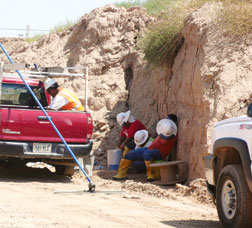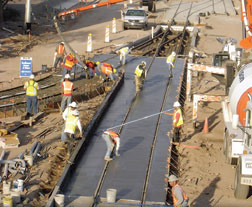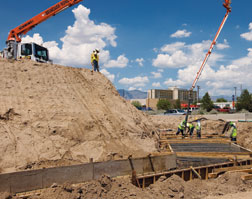...every meeting,” says Josh Welp, Sundt safety representative. “Stay hydrated. If you’re thirsty, you waited too long.”
Every shift starts off with a meeting to discuss the plans for the day. Staying hydrated is a key topic. “There is the issue of drinking [beer] after shifts in the heat—we talk about that,” says Brian Murphy, Sundt safety director, noting that drinking alcohol speeds dehydration.
Standing in a shed fitted with a huge fan, Murphy pointed outside at a cluster of workers laying rebar. “A lot of these guys look like Lawrence of Arabia,” Murphy says, explaining that the long black cloths flowing from beneath hardhats keep moisture close to skin, as do long sleeves and two layers of shirts.
Water trucks drive about the 40-acre site, occasionally spreading water to tamp down the dust. A Spanish-speaking roofer, like other workers, keeps a gallon jug of water nearby. Water and Gatorade are key—but not salt tablets, says Murphy. “A lot of them weren’t buffered, so guys got sick,” he says.
Standing on the roof of a 30-ft deep, 140-ft-wide, 280-ft-long reservoir under construction, Sundt concrete superintendent Shawn Werner noted that roof slabs recently were poured at 1 a.m. He pointed toward the interior of the structure where, surrounded by earth, workers are installing fiber-reinforced wall beams to concrete columns. “When concrete hydrates, it heats up,” he says. Despite fans, he estimates it gets as hot as 140° within the enclosed structure. “It’s as close to Purgatory as you can get,” he says.
Heat Symptoms
 Aileen Cho /ENR Workers are encouraged to take breaks in the shade.
|
In Glendale, Sundt is working an $18-million job to install 10,500 ft of storm drain varying in diameter from 24 in. to 90 in. Crews working in a 20-ft-deep trench endure triple-digit temperatures, excavating 200 cu yd of material every 30 ft and laying up to 96 ft of pipe per day. As an excavator scooped up earth behind him, Hedy Bagherpour, Sundt area manager, recalled a time when cabs did not have air conditioning. He keeps an eye on new hires, especially student interns. Years ago he saw a worker faint on a dam job. “We called 911 and put cool rags on his body,” he says. “It took him a couple of hours to come out of it.”
Those symptoms are typical of “heat syncope,” says Paul Sprecco, Sundt’s San Diego-based area safety manager. “Blood vessels in the skin and in the lower part of the body dilate, which may cause blood to pool there,” says. That may cause fainting.
Other signs of heat exhaustion include flushed, clammy or red skin, heavy sweating, headache or dizziness and fatigue. Sundt’s Welp says a handful of these incidents occurred during summer construction of Phoenix’s just-completed $1-billion, 20-mile Phoenix light rail project.
 Sundt Light rail job had heat incidents.
|
“None of them were serious because the symptoms were caught early,” says Hillary Foose, a spokesperson for owner METRO. “The heat in the valley is extreme. We have to be diligent in monitoring for cues of heat-related incidents.” She says new safety vests are being used with mesh to allow more airflow.
Heat stroke is life-threatening, requiring immediate medical attention. Signs include lack of sweating, confusion, irrational behavior, unconsciousness, convulsions, hot, dry skin and body temperature reaching 105.8°. “If your co-worker isn’t sweating, it’s time to intervene,” says CPWR’s Watters. In all cases, the first step is have the victim lie down in a cool area, soak the clothes, bathe the skin in cool water and apply ice packs.
 Michael Goodman /ENR Tucson was “only” 107° recently, while Phoenix reached 117°.
|
Federal guidance on heat stress and related illnesses comes largely through publications and references distributed by the Occupational Safety and Health Administration. A new resource is the Heat Illness e-tool developed by the California Dept. of Occupational Safety. California pioneered mandatory heat-related standards for employers of outdoor occupations after a dozen heat-related deaths in 2005.
The e-tool identifies high-risk situations, extra measures for “heat wave” conditions, prevention “best practices” and emergency response procedures. It offers suggestions for implementing workplace heat-stress training and awareness programs, and downloadable bilingual posters, pamphlets, and videos.
But none of the information will help if it is not read. “There’s still the issue of getting [information] not only to workers, but to employers,” says Chad Dowell, industrial hygienist with the National Institute for Occupational Safety.

Post a comment to this article
Report Abusive Comment